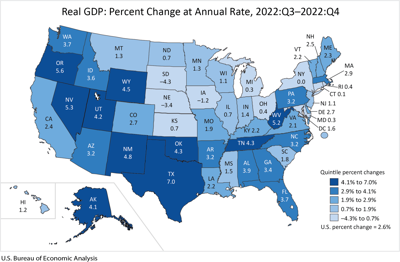

- By Bethany Blankley


(The Center Square) – Texas continues to lead the U.S. with the fastest economic expansion, according to new data released by the Bureau of Economic Analysis.
As measured by Texas’ gross domestic product, the value of all goods and services it produces, the Texas economy expanded at an annual rate of 7% – nearly triple the national GDP rate of 2.6%.
“It is no surprise that Texas continues to lead the nation, thanks to the hardworking men and women of this great state who have built the most dynamic economy in America,” Gov. Greg Abbott said. “This astounding economic growth in Texas, reflected also in our state’s nation-leading and record-smashing job creation, is further proof that when given the freedom to succeed, businesses invest and people aspire. That is truly the secret to the Texas model. Together, we are building an even greater Texas of tomorrow.”
Real gross domestic product increased in 46 states and the District of Columbia in the fourth quarter of 2022, led by Texas, the BEA reported.
“Current-dollar GDP increased in 45 states and the District of Columbia,” it reported; in 2022, “real, or inflation-adjusted, GDP increased in 42 states and the District of Columbia.”
Following Texas, the next states reporting the greatest percentage change of real GDP were Oregon (5.6%), Nevada (5.3%), West Virginia (5.2%), New Mexico (4.8%), Wyoming (4.5%), Tennessee and Oklahoma (4.3% each), Utah (4.2%) and Florida and Washington (3.7% each).
The professional, scientific, and technical services industry increased in all 50 states and the District of Columbia, the BEA reported. Industry gains were the leading factor in 15 states’ GDP gains, it said.
Retail trade increased in all 50 states and the District of Columbia and was the leading contributor to the GDP increase reported in 10 states.
The mining industry increased in 49 states and was the leading contributor to states reporting the greatest percentage of GDP increases including Texas, West Virginia, New Mexico, Wyoming, and Oklahoma, the states with the first, fourth, fifth, sixth, and seventh-largest increases in real GDP, it said.
The agriculture, forestry, fishing, and hunting industry decreased in 20 states, contributing to GDP decreases in South Dakota, Nebraska and Iowa, the only states reporting decreases.
The highest personal income percent change was reported in Massachusetts of 15.3%, followed by California’s 11%, Nevada’s 10.1%, Idaho’s and Indiana’s 10.9% each, South Carolina’s 9.7%, Utah’s 8.9%, Tennessee’s and Delaware’s 8.6% each, and Florida’s 8.5%.
Professional, scientific, and technical services increased in 49 states and the District of Columbia. This industry was the leading contributor to GDP increases in 13 states and the District of Columbia.
The information industry increased in 47 states and the District of Columbia and was also the leading contributor to the increase in eight states including Texas, the state with the fifth-largest increase, the report found.
The real estate and rental and leasing industry increased in 43 states and the District of Columbia, also acting as the leading contributor to increases in six states including Idaho and Florida, the states with the first and third-largest increases.
The mining industry decreased in 28 states and was the leading contributor to the decreases in Alaska, North Dakota, Oklahoma, and Wyoming, the states with the first, fourth, fifth, and sixth-largest decreases, the report found.
TELL YOUR FRIENDS ABOUT CITIZENS JOURNAL Help keep us publishing –PLEASE DONATE



